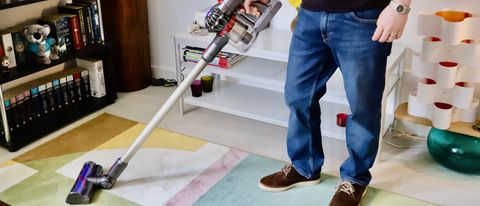TechRadar Verdict
Sitting in between the Omni-Glide and the much more expensive Cyclone V15 handstick, the Dyson V8 offers a powerful option for those wanting a Dyson vacuum for less. Despite originally launching way back in 2016, it still offers great performance, with good suction and 40 minutes of battery life on its standard setting. You can still get cheaper in this category, but the Dyson V8 is a lightweight, heavy-duty dust buster that can replace the traditional corded vacuum cleaner in most households.
Pros
- +
Versatile 2-in-1 design
- +
Easy-to-empty bin
- +
Powerful suction
Cons
- -
Expensive
- -
Long charging time
- -
Small bin
Why you can trust TechRadar
One-minute review
Following a reshuffle of the Dyson lineup and the discontinuation of a couple of models, the Dyson V8 is now the entry-level option in Dyson’s cordless vacuum line-up for anyone that has carpet (there is the Omni Glide for hard floors below it). Having been initially launched back in 2016, it’s also one of the oldest models, but it still manages to impress with its performance — especially now it’s had a recent price drop.
Like all the other Dyson handsticks, there are a few different versions of the V8 available. They all share the same motor and battery – the only real difference between them all is the number of extra tools they ship with, so do check which one best suits your needs.
Dyson’s recognisable design aesthetic runs through all of its models and the V8 is no different. You get a transparent 0.54L dustbin that makes up the bulk of the handheld unit, with 15 small cyclone cones arranged in a two-tier flower shape in front of it. Now with better sealing throughout the vacuum cleaner, the V8 traps most microscopic particles, to help people with allergies. It is also the first Dyson handstick to feature the company’s improved bin-emptying mechanism, for greater hygiene when ditching the dirt.
The Dyson V8 isn’t just for floors – it quickly converts into a handheld minivac that can be used to clean upholstery at home, in the car, on the boat, or anywhere else you can think of. You can even get to ceiling corners without hurting yourself.
Wherever you use it, performance is strong across the board. Of course, if you’re buying it primarily as a car vac, it’s pretty expensive, but as your main vacuum cleaner, offering the option to shapeshift to other use cases makes it quite a handy machine to have in your cleaning arsenal.
Battery life is good on standard suction mode, although the seven minutes in Max mode is a touch short. Thankfully we found it could pick up most debris on the lower setting with an occasional blast on the higher setting doing a good job of collecting anything left over.
If you can afford its highish price tag, the Dyson V8 is a hugely versatile machine for just about anyone, and might just be the only vacuum cleaner you will ever need.
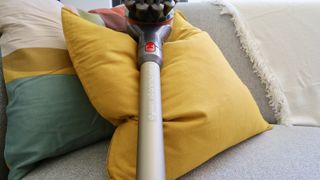
Price and availability
- List price: $449 / £249 / AU$499.
As we mentioned earlier, the V8 is actually the oldest handstick model in Dyson’s current range. It was launched in 2016, but that doesn’t mean it’s particularly cheap. While prices have dropped since we first tested the V8, its starting price still remains relatively high at $449 /£249/AU$499, direct from Dyson’s website.
In the UK, the base model you get for that price is the V8 Animal (in fact, it’s the only V8 model listed on Dyson UK’s website), while in Australia, it’s the V8 Origin and in the US, it’s just the V8. While looking for somewhere to purchase, check out the latest Dyson promo codes to see how you can save more.
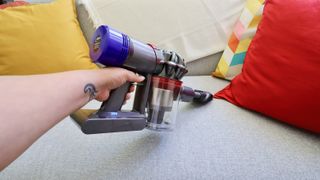
Design and handling
- Versatile 2-in-1 design
- Reasonably ightweight
- Easy to maneuver
Every single Dyson product has a design aesthetic that’s very appealing, and the same philosophy applies to the V8 as well.
You get a transparent 0.54L dustbin that makes up the bulk of the handheld unit, with 15 small cyclone cones arranged in a two-tier flower shape in front of it. It weighs 3.5lbs/1.6kg with no attachments, and at its heaviest, it weighs 5.6lbs/2.6kg (with the wand and main cleaning head attached). For a household vac, that’s pretty lightweight, but it’s a little on the heavier side when considering comparable handheld vacs for car cleaning.
The handle is broad and comfortable, even for people with small hands, and the power button – which resembles a trigger – is ergonomically placed just where your forefinger should be.
Like most other handsticks, though, you will need to keep your finger on the power trigger for the entire duration of your clean for the vacuum to run continuously. This can be uncomfortable for some people (people with hand and wrist injuries, for example), but for most users shouldn't be a problem at all.
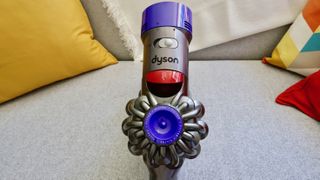
Above that, there's a HEPA filter encased in blue/purple plastic, with air vents on the sides. Below the filter and air vents is the toggle switch to change suction power – there are just standard and max settings to choose from on the V8.
A large red tab on the handheld unit with a bin icon is what you’ll need to pull when the dustbin needs emptying. This was the design change that Dyson introduced with the V8 – pulling on the tab forces the cyclone part of the main unit to rise while forcing the base flap to open simultaneously. Lo and behold, dust, debris and hair fall out, with only a very thin layer of fine particles sticking to the interior of the bin.
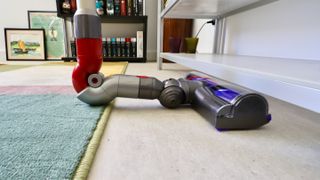
As mentioned before, the V8 comes with a bunch of accessories, including a telescopic tube that’s perfect for general use. Every tool clips easily on and off the main handheld unit, even with one hand. The standard direct-drive head is great on pretty much any surface, but if you happen to buy the V8 Absolute, you’ll get a Soft Roller cleaning head that’s the best option for hard floors.
Using soft fibers and carbon bristles on a rotating bar, the Soft Roller is designed to glide directly over floors, and this means that if you have larger debris (like kitchen spills) that need cleaning up, they’re not scattered willy nilly. And, depending on which V8 model you opt for, you also get a low-reach adaptor that you can fit onto the end of the telescopic tube to get under couches and low tables (as pictured in the image above).
When using it as a car vac, we loved the crevice tool for getting into narrow spaces and mini motorhead tool for collecting bigger messes in the boot space.
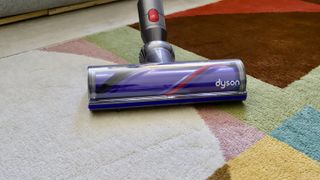
No matter which cleaning tool you use, the V8 remains well balanced and, thanks to swivelling heads, moving the handstick along hard floors and carpets is a breeze.
Performance
- Powerful despite its age
- Up to 40 minutes battery life
- On the loud side for cordless vacs when on Max suction
Dyson has been improving suction power on its handsticks with each generation, but the V8 was the benchmark to work from. Despite having an older motor, the Dyson V8 generates as much suction power as a budget corded vacuum cleaner, particularly when on its max power setting. And compared to the cordless competition, it can give even some newer models a run for their money.
From a noise perspective though, it’s among the noisier cordless home vacuums we have tested, at 80dB on max setting and 75dB on standard. However, it does depend on what market you’re comparing it in, as those levels actually make it one of the quieter handheld car vacs. Overall, it’s unlikely to annoy you - particularly on the standard setting.
On carpets, the motorized direct-drive head does a fantastic job. It’s pretty good on hard floors as well, but if you can get the Soft Roller (or Fluffy) tool, there’s nothing like it on wood and tiles. Alternatively, you can use the mini motorized tool on hard floors, but its footprint is small, and you’ll need to go over the floor several times to finish a room. And that eats into the V8’s limited battery life.
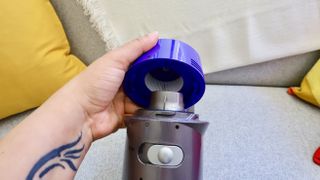
We found it to be great at picking up both large and finer dirt in our in-car tests, using the mini motorhead tool which was a great size for most debris on carpet and upholstery. The crevice tool also worked great for getting into tighter areas, like into door bins, behind pedals and in-seat folds, and is long enough to counteract the V8’s larger body than most other handheld vacs.
Back to home use, and as with the other Dyson handsticks, the V8’s edge-cleaning prowess is pretty darn impressive. Where other budget vacuum cleaners don’t have the power or the right design to ensure dirt along skirting boards and corners get sucked up, the V8 can handle the 90-degree angle along the edges of rooms and in most corners as well. This is also helped by how well most of the cleaning heads swivel on their own axes.
Then there are the two-tier radial cyclones that push air through 15 small conical chutes to generate a significant amount of centrifugal force that can suck up very small particles. Combine that with the V8 motor spinning at 110,000rpm and a decent bin size, and you’ve got a lean, mean, sucking machine that’s likely going to be the only vacuum cleaner you’ll ever need — be that in the home, car or anything in between.
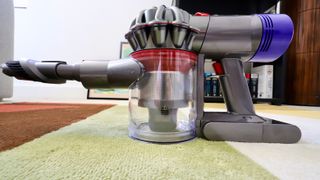
Battery life
Should I buy the Dyson V8?
There’s up to 40 minutes of fade-free power available with the V8 on a single charge, and that holds true even when using the motorized cleaning tools (like the direct-drive and soft roller heads) — which is not something we were expecting.
When the battery has drained, the motor just switches off, with no reduction in suction prior to that, so you get consistent power and performance for the full 40 minutes.
On the max setting, though, the V8 lasts for much less time – you’ll get no more than seven minutes of use. This renders the Max setting good for only spot deep cleans and great for quick car cleanups, but thankfully the V8's standard setting is more than enough for most debris.
40 minutes of battery life is usually enough for an average-sized one-bedroom apartment, but if you live in a larger space, you'll need to charge the V8 again, which can take about five hours for a full top-up.
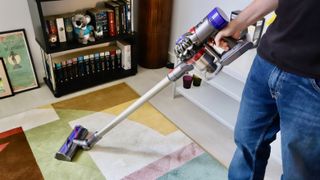
Buy it if...
You’re after a powerful handstick vacuum cleaner
The V8 performs admirably and offers a 40-minute battery life — enough for tackling smaller homes and cars in one fell swoop.
You need a versatile cleaning appliance
Whether it’s getting rid of cobwebs from your house, getting hair off your sofa and cushions, and even giving the car interior a once-over, the V8 can handle it all.
You have the money to spare
It might be getting on in age, but the Dyson V8 is not cheap. Its performance speaks for itself but it is still comparatively more expensive than much of its competition.
Don't buy it if...
You live in a large home
With only a 40-minute runtime, you might want to consider spending extra on the Dyson V15 or opt for a cordless with better battery life if your family home is large.
You’re on a budget
It’s remarkably easy for us to recommend the V8 to most people, but if you don’t have the spare change, we’d suggest looking at other brands like Electrolux, Bissell or Shark.
You need a larger capacity dustbin
Large homes, particularly ones with wall-to-wall carpeting and pets, might find that the V8’s 0.54L bin fills up very quickly, requiring frequent emptying.
- We've rounded-up the best vacuum cleaners you can currently buy

Sharmishta is TechRadar's APAC Managing Editor and loves all things photography, something she discovered while chasing monkeys in the wilds of India (she studied to be a primatologist but has since left monkey business behind). While she's happiest with a camera in her hand, she's also an avid reader and has become a passionate proponent of ereaders, having appeared on Singaporean radio to talk about the convenience of these underrated devices. When she's not testing camera kits or the latest in e-paper tablets, she's discovering the joys and foibles of smart home gizmos. She's also the Australian Managing Editor of Digital Camera World and, if that wasn't enough, she contributes to T3 and Tom's Guide, while also working on two of Future's photography print magazines Down Under.
